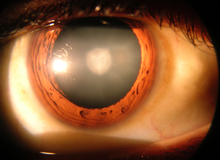
Back Katarak Afrikaans Katarakt (Medizin) ALS الساد Arabic ميه بيضا ARZ Katarakta Azerbaijani کاتاراکت AZB Muting BCL Катаракта Byelorussian Катаракта Bulgarian ছানি Bengali/Bangla
| Cataract | |
|---|---|
 | |
| Magnified view of a cataract seen on examination with a slit lamp | |
| Specialty | Ophthalmology, Optometry |
| Symptoms | Faded colors, blurry vision, halos around light, trouble with bright lights, trouble seeing at night[1] |
| Complications | Falling, depression, blindness[2][3] |
| Usual onset | Gradual[1] |
| Causes | Aging, trauma, radiation exposure, following eye surgery, genetic[1][4][5] |
| Risk factors | Diabetes, smoking tobacco, prolonged exposure to sunlight, alcohol[1] |
| Diagnostic method | Eye examination[1] |
| Prevention | Sunglasses, proper diet, not smoking[1] |
| Treatment | Glasses, cataract surgery[1] |
| Frequency | 60 million (2015)[6] |
A cataract is a cloudy area in the lens of the eye that leads to a decrease in vision of the eye.[1][7] Cataracts often develop slowly and can affect one or both eyes.[1] Symptoms may include faded colours, blurry or double vision, halos around light, trouble with bright lights, and difficulty seeing at night.[1] This may result in trouble driving, reading, or recognizing faces.[8] Poor vision caused by cataracts may also result in an increased risk of falling and depression.[2] Cataracts cause 51% of all cases of blindness and 33% of visual impairment worldwide.[3][9]
Cataracts are most commonly due to aging but may also occur due to trauma or radiation exposure, be present from birth, or occur following eye surgery for other problems.[1][4] Risk factors include diabetes, longstanding use of corticosteroid medication, smoking tobacco, prolonged exposure to sunlight, and alcohol.[1] The underlying mechanism involves accumulation of clumps of protein or yellow-brown pigment in the lens that reduces transmission of light to the retina at the back of the eye.[1] Diagnosis is by an eye examination.[1]
Wearing sunglasses and a wide brimmed hat, eating leafy vegetables and fruits, and avoiding smoking may reduce the risk of developing cataracts, or slow the process.[1][10] Early on, the symptoms may be improved with glasses.[1] If this does not help, surgery to remove the cloudy lens and replace it with an artificial lens is the only effective treatment.[1] Cataract surgery is not readily available in many countries, and surgery is needed only if the cataracts are causing problems and generally results in an improved quality of life.[1][11][4][12]
About 20 million people worldwide are blind due to cataracts.[4] It is the cause of approximately 5% of blindness in the United States and nearly 60% of blindness in parts of Africa and South America.[12] Blindness from cataracts occurs in about 10 to 40 per 100,000 children in the developing world, and 1 to 4 per 100,000 children in the developed world.[7] Cataracts become more common with age.[1] In the United States, cataracts occur in 68% of those over the age of 80 years.[13] Additionally they are more common in women, and less common in Hispanic and Black people.[13]
- ^ a b c d e f g h i j k l m n o p q r s "Facts About Cataract". September 2009. Archived from the original on 24 May 2015. Retrieved 24 May 2015.
- ^ a b Gimbel HV, Dardzhikova AA (January 2011). "Consequences of waiting for cataract surgery". Current Opinion in Ophthalmology. 22 (1): 28–30. doi:10.1097/icu.0b013e328341425d. PMID 21076306. S2CID 205670956.
- ^ a b "Visual impairment and blindness Fact Sheet N°282". August 2014. Archived from the original on 12 May 2015. Retrieved 23 May 2015.
- ^ a b c d "Priority eye diseases". Archived from the original on 24 May 2015. Retrieved 24 May 2015.
- ^ Chan WH, Biswas S, Ashworth JL, Lloyd IC (April 2012). "Congenital and infantile cataract: aetiology and management". European Journal of Pediatrics. 171 (4): 625–630. doi:10.1007/s00431-012-1700-1. PMID 22383071. S2CID 195680440.
- ^ Vos T, Allen C, Arora M, Barber RM, Bhutta ZA, Brown A, et al. (October 2016). "Global, regional, and national incidence, prevalence, and years lived with disability for 310 diseases and injuries, 1990-2015: a systematic analysis for the Global Burden of Disease Study 2015". Lancet. 388 (10053): 1545–1602. doi:10.1016/S0140-6736(16)31678-6. PMC 5055577. PMID 27733282.
- ^ a b Wilson Jr ME, Trivedi RH, Pandey SK (2005). Pediatric cataract surgery techniques, complications, and management. Philadelphia, Pennsylvania: Lippincott Williams & Wilkins. p. 20. ISBN 978-0-7817-4307-5. Archived from the original on 2015-05-24.
- ^ Allen D, Vasavada A (July 2006). "Cataract and surgery for cataract". BMJ. 333 (7559): 128–132. doi:10.1136/bmj.333.7559.128. PMC 1502210. PMID 16840470.
- ^ Global Data on Visual Impairments 2010 (PDF). WHO. 2012. p. 6. Archived (PDF) from the original on 2015-03-31.
- ^ "Recognizing Cataracts". NIH News in Health. 2017-05-30. Retrieved 2020-02-02.
Try wearing sunglasses or a hat with a brim. Researchers also believe that good nutrition can help reduce the risk of age-related cataract. They recommend eating plenty of green leafy vegetables, fruits, nuts and other healthy foods.
- ^ Lamoureux EL, Fenwick E, Pesudovs K, Tan D (January 2011). "The impact of cataract surgery on quality of life". Current Opinion in Ophthalmology. 22 (1): 19–27. doi:10.1097/icu.0b013e3283414284. PMID 21088580. S2CID 22760161.
- ^ a b Rao GN, Khanna R, Payal A (January 2011). "The global burden of cataract". Current Opinion in Ophthalmology. 22 (1): 4–9. doi:10.1097/icu.0b013e3283414fc8. PMID 21107260. S2CID 205670997.
- ^ a b "Cataract Data and Statistics". National Eye Institute. Retrieved 2019-11-18.